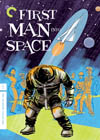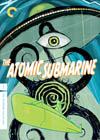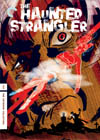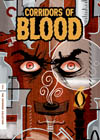![[box cover]](../../reviewimgs/m/monstersandmadmen_cc.jpg)
![[box cover]](../../reviewimgs/m/monstersandmadmen_cc.jpg)
|
Monsters and Madmen: The Criterion CollectionCriterion spine number 364,
|
Review by Mark Bourne
Occasionally Criterion, the high-end dealer in cinematic Porsches and Lamborghinis and Rolls-Royces, surprises us with a DVD release of a vintage Studebaker. When they trick out a B-movie genre film — see Equinox, The Blob, and, connected to our current subject, Fiend Without a Face — with the glossy paint job and Cadillac fins that typically distinguish their art-house and classics titles, the results can be as welcome to the "monster kids" and other devotees of elegant trash as any new edition of a Renoir or Bergman film is to a Cahiers du cinéma subscriber. (Besides, those two audiences overlap a lot more often than most of us tend to acknowledge.)
This time, boxed within the four-disc Monsters and Madmen set, Criterion gathers a niche-market quartet of "B" films from 1958 and '59: two handsomely mounted gothic creepers starring late-career Boris Karloff, plus a pair of camp-and-kitsch Space Age boilerplates that'll never make anyone's list of milestone sci-fi. There's not a masterpiece among them, but each is sufficiently enjoyable to the suitably minded. What links all four are their British producers, Alex and Richard Gordon, brothers who had grown up as fans of the good old shock-and-schlock stuff, then parlayed their enthusiasm into making their own movies against the usual odds of frugal budgets, short-order shooting schedules, and disinterested studios.
While avoiding the rather embarrassing hyperbole Criterion glittered onto their edition of Richard Gordon's Fiend Without a Face, the Monsters and Madmen set upholds Criterion's reputation for well-made and authoritative extras supporting the main attraction. Here each film comes with a lively and informative commentary track by at least one of the Gordon brothers, hosted by genre expert and film historian Tom Weaver. (Actor Yvonne Romain pops up during the Corridors of Blood track.) Recorded in 2002 and 2003, Weaver's informed, fannish conversations with the Gordons release a wealth of info on genre film history, the workaday details of these productions, backgrounders on the casts, and the difficulties the Gordons experienced finding funding and distribution, cutting corners when necessary, and getting the movies completed on time. At age 80, gregarious Alex (who died in 2003, his material recorded eight months prior) shows off a steel-trap memory with production histories and minutiae on everyone involved, from the directors to each character actor and day player on the screen. By all accounts Karloff was a sweet old English gentleman both on and off the set. Not all of the looking-back is such fond reminiscing, with Christopher Lee being painted as something of a dick even before he was famous. Richard Gordon recalls his dismay at Ed Wood's directing techniques, and offers some blistering words for the writers of Tim Burton's Ed Wood, who turned Bela Lugosi into a foul-mouthed grouch that he was not.
Each film comes with a new retrospective featurette from Weaver's video interviews with cast members and production personnel. Rounding out each film's extras is its original theatrical trailer and radio spots, and a click-through gallery of production stills, photos of cinema marquees on opening day, and sometimes outrageous press-kit material that makes us wonder if in those days copywriters got paid by the exclamation point. A booklet with new essays and vintage material comes packaged within each of the set's two double-disc cases.
All that on top of new digital transfers from 35mm fine-grain black-and-white prints (1.33:1 open matte in every case) refurbished with Criterion's usual attention to quality. Particularly the two Karloff films, The Haunted Strangler and Corridors of Blood, look freshly minted. The clean DD 1.0 audio tracks, mastered at 24-bit from the 35mm optical soundtrack negatives, are free of hiss or wear.
The snappy, stylized artwork on the outer box and, inside, for each of the four titles comes from artist Darwyn Cooke, who evokes the distinctive retro look of UPA animated cartoons, 75-cent paperback novels, and diner menus.




Space Age hardware footage (including cockpit shots of Chuck Yeager) meets rampaging space-mutant theatrics in The First Man Into Space (77 mins., Criterion spine no. 365). In this interstellar cautionary tale, brash U.S. Navy test pilot Dan Prescott (Bill Edwards), hungry for fame, rockets himself beyond Earthís atmosphere, only to become encrusted with cosmic dust and return a blood-drinking monster.
One of several films that took more than a few pages from Britain's superior The Quatermass Experiment ('55), this 1959 slapdash quickie stars genre stalwart Marshall Thompson as the responsible brother, also a test pilot, who leads the search for his doomed sibling. Along the way he also scoops up his brother's girlfriend (Marla Landi, who locked lips with Christopher Lee in Hammer's The Hound of the Baskervilles). Understandably, she prefers the brother who isn't a marauding burnt-marshmallow vampire with super-human strength and a newfound devotion to mutilating cattle and blonde nurses. (He's bullet-proof too, but remembers how to drive a Ford Fairlane.) For good measure we get a stereotypical German scientist and, in a dreadful scene that exists only for flat-footed comic relief, a stereotypical Mexican. The Mexican is played by Roger Delgado, recognizable to fans of classic early-1970s-era Doctor Who as the original "The Master" already sporting his Beard of Evil.
Directing The First Man Into Space with straight-ahead, workmanlike inoffensiveness was Robert Day, better known for Two Way Stretch, several episodes of TV's "The Avengers" with Diana Rigg, and both Karloff films in this set. The script is banal and takes too long to get moving, but once the deep-fried Dan returns to Earth the pace is brisk enough to the end. Given its subtexty themes common to the era's sci-fi films (scientific hubris and Cosmic Things Best Left Alone), plus the conclusion's pathos in Dan's misfortune, with generous editing The First Man Into Space might have made a mid-grade episode of TV's original The Outer Limits. In the U.K., it played as Satellite of Blood, a handy hook for sharing a double-bill with the Karloff creeper Corridors of Blood that same year.
In the new featurette, Making Space (9 mins.), Weaver interviews Robert Day, who confesses to being no fan of science fiction when he directed The First Man Into Space, and Marla Landi, who has warm memories of her co-stars and the production.
* * *
The Atomic Submarine (72 minutes, Criterion no. 366) is to James Cameron's The Abyss what It! The Terror from Beyond Space is to Ridley Scott's Alien. There may or may not be any direct cribbing from one to the other, but either way the similarities remind us that the movies are our greatest recycling resource. When a nuclear-powered submarine, the Tiger Shark, sets out to investigate a series of mysterious disappearances near the Arctic Circle, its fearless crew finds itself besieged by electrical storms, an Unidentified Floating Saucer, and lots of hairy tentacles.
This charmingly cheapjack Allied Artist sci-fi/horror/bathtub adventure was directed by Spencer Gordon Bennett, who cut his quick-B chops on dozens of westerns, serials (including Captain Video and Batman and Robin) and programmers such as The Purple Monster Strikes. (Befitting the "King of Serial Directors," the inscription on his tombstone reads "His Final Chapter.") Even for a meager exploitation film, The Atomic Submarine isn't anything to brag about, but it did allow Alex and Richard Gordon to fill their cast with veteran stars of westerns, monster features, and other pop favorites. Arthur Franz, Dick Foran, Tom Conway, Brett Halsey, Victor Varconi, Bob Steele, Selmer Jackson, Jack Mulhall, and Joi Lansing make The Atomic Submarine the sort of Who's Who ensemble that drinking games are made on.
The Atomic Submarine was shot in eight days on a budget of $135,000. Ample stock footage is ungainly stitched to sequences depicting the toy-boat submarine passing repeatedly through the same aquarium scenery. The sub's interior is mighty roomy for so little instrumentation, and the minimalist interior of the alien saucer is an empty soundstage of dimensionless, albeit atmospheric, darkness. Once our heroes break into the saucer and discover the would-be Earth-conquering monster causing all the ruckus, the giant seaweedy Cyclops may be a first cousin to the bulbous beasties in 1958's The Crawling Eye, but it's still quaintly delightful as a puppet more effective (though no less gigglesome) than the usual stuntman in a zippered rubber Alien Invader costume. There's something sublime in the hairy eyeball's "telepathic" baritone introduction to Arthur Franz: "So, Commander Holloway, as you Earth inhabitants would express it, we meet ... face to face!" Let's not forget the bombastic narrator ("Adapt a complicated guidance system to a huge ballistic rocket, convert it to a water-to-air intercept missile? It was foolish, it was insane, it was fantastic! But it was their only hope. And the Earth's only hope!"). And Alexander Laszlo's Theremin-heavy musical score adds to the cheese factor with "electro-sonic" gusto.
The menu item War Under the Arctic Ice holds this film's collection of extras. The main attractor here is the featurette, Atomic Recall (16 mins.), an interview with actor Brett Halsey supported by film clips and production photos. He reminisces about his co-stars, which included "some of the idols of my youth," and Alex Gordon ("everyone liked to be around Alex").
Packaged with the Atomic Submarine and First Man Into Space discs is a 20-page booklet featuring affectionate new essays by Michael Lennick (www.foolishearthling.com) and Bruce Eder. It's illustrated with production shots and publicity images ("Nervo-Rama ... For People With NERVES of Iron Only!!!").
* * *
Boris Karloff was entering his 70s during production of The Haunted Strangler (a.k.a. Grip of the Strangler, 79 mins., Criterion no. 367). But nearly thirty years after Frankenstein, and much sooner after a spate of minor roles in sub-subpar chillers, he's again near the top of his game as the best thing about this slow but effective Victorian who-actually-done-it. 19th-century English author James Rankin (Karloff) believes that the wrong man was hanged twenty years earlier for a series of murders, but his investigations lead him to a horrible, and, for him, gruesomely inescapable secret.
In this Jekyll-and-Hyde suspense semi-thriller, Karloff transforms gentle novelist James Rankin into the slavering Haymarket Strangler with little more than facial contortions, palsied hands, and the removal of his false teeth. It's a transformation that almost steps over the line into the comical, but Karloff's is far more successful that Spencer Tracy's similar attempt in 1941. He's as watchable and charismatic as ever, with a voice made for the movies. The film is otherwise routine fare, but there are some good macabre moments as well as characteristically English touches in the gaslit Victorian atmospherics and the opening scene of a hanging as an afternoon's entertainment. Can-Can girls and Vera Day's robustly cantilevered breasts help lighten the gruesome goings-on.
In the featurette, Haunted Memories (12 mins.), director Robert Day, screenwriter Jan Read, and co-stars Jean Kent (The Browning Version) and Vera Day (Quatermass 2, Lock, Stock, and Two Smoking Barrels) recall making the film and their own pleasant on- and off-set experiences with "gentle and sophisticated" Karloff.
* * *
1958's Corridors of Blood (87 mins., Criterion no. 368) is the best film in the box, again featuring an on-the-money Karloff as a kindly protagonist at odds with his inner drives and compulsions. In 1840s London, Dr. Thomas Bolton (Karloff) dares to dream the unthinkable: to operate on patients without causing pain. Unfortunately, the road to general anesthesia is blocked by a ruthless killer (Christopher Lee), as well as Boltonís devastating addiction to his own chemical experiments.
Whereas the lurid title brings to mind a fearsome yarn of mad slashings and other terror-film tropes, Corridors of Blood instead comes across more as a combination murder mystery and romanticized docudrama about the Heroic Scientist selflessly bringing light to a benighted age of brutal amputations without anesthetia. The script pieces together elements from the infamous Burke and Hare hospital bodysnatching case (fictionalized many times, as in The Doctor and the Devils and Karloff's earlier The Body Snatcher) and a then-bold depiction of drug addiction as Dr. Bolton succumbs to the opiates he huffs in his search for a humane surgical anesthetic gas. The production values are high with richly Dickensian sets, especially the squalid Seven Dials district of London. The last reel ups the action satisfactorily, with a police raid on the bad guys' lair and a fall from a rooftop to a nasty impaling.
So it's a musty but good-looking production, with Karloff splendid as the devoted surgeon pulled asunder by his own experiments and exploited by the underworld gang of tavern low-lifes who trick him into officializing their corpses-for-profit scheme. Hands down, the biggest impression among the grotesques comes from the sinister, top-hatted murderer Resurrection Joe, played by young Christopher Lee, whose stardom began that year as Hammer's Dracula. Lee commands your attention every time he appears in the shadows or uses his silky Cockney voice. The rest of the cast is packed with familiar British character actors — Francis Matthews (fresh off Hammer's Revenge of Frankenstein), Francis De Wolff (Hound of the Baskervilles with Lee) as burly Black Ben the innkeeper, Nigel Green (Countess Dracula) as the lead "peeler," Finlay Currie (Ivanhoe), gorgeous Yvonne Warren/Romain, and Adrienne Corri (Renoir's The River and the gang-rape victim in A Clockwork Orange).
Corridor Gossip (14 mins.) brings home new video interviews with director Robert Day and Francis Matthews, who hates watching his character ("gauche, naÔve, and rather boring") in this film. Karloff is once again appropriately lauded for his genteel good nature and professionalism.
Writer Tom Weaver's substantial audio interview with Yvonne Romain is a separate menu item, chapter-listed by her career highlights (Corridors of Blood, Circus of Horrors, Elvis, Devil Doll, etc.).
Censor Cuts (3 mins.) holds scenes originally clipped from the film's belated 1962 release. Starting it off is the typewritten letter Richard Gordon received from Britain's Board of Censors, which slapped the film with an "X" certificate. It specifies the moments that failed to be "acceptable under the Code." Key offenses are Karloff slicing into a conscious patient's leg in a hospital operating theater, Lee stabbing a night watchman, and Lee stabbing Karloff before his face corrodes behind a splash of acid.
The illustrated 20-page booklet accompanying The Haunted Strangler and Corridors of Blood holds an excellent Karloff career overview by Maitland McDonagh (www.maitlandm.com), and a 1984 Fangoria magazine interview with producer John Croydon about Karloff and his experiences on the set of Corridors of Blood.
—Mark Bourne



- Color
- Fullscreen open matte (1.33:1)
- Four single-sided, dual-layered discs (SS-DL)
- Audio Tracks: English (Dolby Digital 1.0)
- Subtitles: English
- Commentary tracks: Tom Weaver with Alex and Richard Gordon
- New featurettes and original marketing material for each film
- Censor Cuts and audio interview with Yvonne Romain for Corridors of Blood
- Two illustrated booklets with essays on the films
- Two dual-spindle keep-cases within a paperboard case
[Back to Review Index] [Back to Quick Reviews] [Back to Main Page]